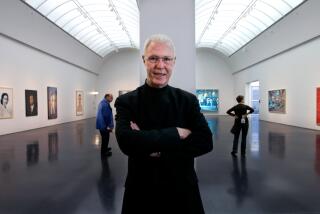Bygones Are Bygones for ConVis and Arts Panel : Tourism: The two agencies, long at odds, have developed San Diego’s first high-level strategy to market the arts to visitors.
- Share via
SAN DIEGO — An unprecedented working relationship between the San Diego Convention & Visitors Bureau (ConVis) and the city’s Commission for Arts and Culture has produced this city’s first high-level plan to market the arts to tourists.
The list of projects ranges from a brochure to promote the arts to a commitment to educate cabdrivers, hotel/motel concierges and other front-line tourism-related employees about what is happening in the local arts scene.
“Some (of the items) seem so common-sensical it’s hard to believe they haven’t been done before,” said Richard Ledford, vice president of community relations for ConVis.
Simple as it may appear, the plan, developed over recent months by a committee composed of three representatives from ConVis and three representatives from the arts commission, represents a major step for the arts community, a group that traditionally has done little collectively to promote itself to tourists.
In addition to the brochure and education program, the 11-item plan, most of which is already being implemented, includes:
* A call for cooperative marketing efforts between arts groups and ConVis.
* A public support campaign, including public service announcements, explaining the value of the arts to San Diego.
* The development of a demonstration project primarily aimed at marketing the arts to business travelers.
If the first steps are successful, more ambitious plans for 1993 and 1994 have already been laid out, including the hiring of a cultural tourism staff member by ConVis, developing a video and setting up an 800 number for arts and culture information.
At the heart of the project is an unprecedented working relationship between ConVis and the arts commission. This is the first time the tourism and arts communities have been able to successfully work together and agree on simple, long-term goals and strategies.
“They’ve tried to do this before, but it didn’t go over well,” said Ledford, who joined ConVis in 1991 after 12 years as chief of staff to Assemblyman Robert Frazee (R-Carlsbad).
Traditionally, the two organizations were wary of each other. Perceived by each other more as adversaries than compatriots, they have often found themselves competing for the same slice of the funding pie--a share of the transient occupancy tax money the city uses to support both groups.
More than anything else, though, there was a fundamental difference in how each viewed the other’s goals. Arts people often saw group and convention travelers as “the people in the funny hats,” said Patti Roscoe, a member of the ConVis board. The arts community wanted to attract tourists interested in the arts, and they didn’t have any interest in bringing in more conventioneers, a target group for ConVis.
Meanwhile, the tourism industry felt it was more important to promote the beaches, Sea World and the rest of the “fun in the sun” elements of San Diego in order to develop “image,” Roscoe said. Research indicated that people were not coming here to go to arts and cultural institutions, so they put little effort into marketing them.
“ConVis, I think, looked at itself as being more involved in the attraction of visitors to San Diego than the servicing of visitors once they were here,” said arts commission member David Thompson, who also worked in the tourism industry for many years. And many arts groups felt “the attraction of visitors wasn’t a basic responsibility for them,” he said.
Tough times and the growth in the quality and quantity of arts and cultural institutions have helped make both groups more aware of their common ground. New members on both sides also sparked the new effort, although there was still a “certain hesitancy in how to communicate with each other,” Roscoe said.
The joint committee was formed in September, and, as part of the research, the committee studied how several other cities were handling cultural tourists. The results were widely varied--ranging from San Francisco, which has a cultural tourism staff member in the convention and visitors bureau, to Pittsburgh, where a special cultural trust with 50 employees handles the responsibility.
Finding other cities dealing with plans to attract cultural tourists was nevertheless inspiring.
“Nothing gets the juices flowing more than to see competitors doing something you’re not doing, and doing it well,” Ledford said.
Both groups found they were committed to the idea of improving the role of arts and culture in tourism.
“It takes a leap of confidence to move to a higher level of service,” Ledford said. “There is no empirical data to support the idea that cultural tourism means big dollars.”
But everyone involved is convinced that the arts community and tourism industry can enhance each other’s existence. Victoria Hamilton, executive director of San Diego’s Commission for Arts and Culture, is particularly excited about the idea of cooperative marketing and including arts organizations in advertisements that appear in other parts of the country for hotels and other local attractions.
Most arts and cultural groups “don’t have the marketing budget to do regional radio and television” ads in other areas, said Hamilton, who took over the newly created arts and culture commission four years ago. “If we can find ways to put together partnerships or packages, that, to me, is going to be challenging. And if we can succeed, then it is going to be an important component” of the plan.
That the first phase of the plan is modest is no accident. Both groups believed it was more practical to start small.
“We felt we were venturing into somewhat uncharted waters,” Thompson said. “If the first bite was too big for us to chew, we felt it would be unproductive.”
Success of the first phase of the plan will be measured not by numbers of tourists, but by such factors as the level of awareness of both tourists and the tourism industry of the cultural scene and the basic working relationship between the new partners.
One element calls for ConVis to offer nonprofit arts and culture groups a special membership rate in ConVis to encourage participation of the arts groups. ConVis also will pay for Hamilton to visit a tourism trade show later this year in order to give her a better feel for the industry.
In addition, by keeping the project small, the two groups will be able to keep funding in-house, without immediately going to the city for additional funds. ConVis is seeking corporate sponsors to help pay for the brochure, but with either ConVis or the commission acting as the responsible project for each item, the initial costs to both will be negligible and can be absorbed by existing programs.
One of the items in the plan calls for ConVis to rephrase a part of its expensive annual research project in order to allow more open responses about the arts. Now, the arts are lumped in with Sea World, the zoo and other attractions when tourists are asked about why they come to San Diego.
If the response is favorable, the groups will probably move ahead in 1993 with Phase II of the plan. It will include a fundamental shift in philosophy, in which the arts will be treated in much the same way as Sea World and the zoo have been, as primary attractions for the city, creating what Roscoe calls a “balanced” destination.
Turning the perception of San Diego from a beach destination to a cultural destination won’t happen quickly, Roscoe said. “Changing the image of a city takes a lot of time and money.”
But it is clear that ConVis and the arts commission are now talking the same language. Most important, Ledford says, the relationship between ConVis and the commission, once “tenuous,” is now “rock-solid.”
“I contend that if you look at the profile of the typical visitor here, it fits the profile of the cultural patron,” Hamilton said. “The idea of attracting cultural tourists economically makes good sense.”
More to Read
The biggest entertainment stories
Get our big stories about Hollywood, film, television, music, arts, culture and more right in your inbox as soon as they publish.
You may occasionally receive promotional content from the Los Angeles Times.










